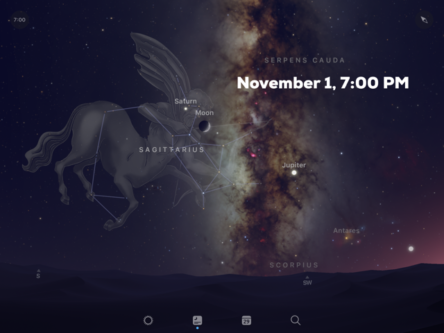
• NOV 1 – The waxing crescent moon is just to the west of Saturn. Jupiter lies just a bit further west of the moon. Both the moon and Jupiter straddle the summer Milky Way.
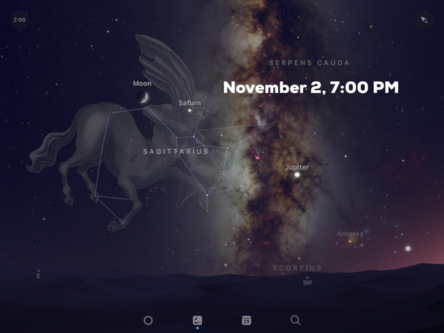
• NOV 2 – Tonight, the crescent moon is now to the east of Saturn.
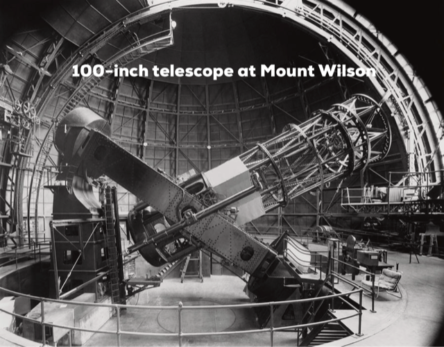 On this day in 1917, the Mount Wilson 100 -inch telescope sees “first light”. First light is when a telescope is used to make its first observation of a celestial object. Conceived by George Ellery Hale, the 100-inch Hooker Telescope, was the worlds largest telescope from 1917 to 1949. Edwin Hubble used the telescope to discover that the Andromeda Galaxy lay outside our own Milky Way and that the universe is expanding. During the 1930’s, astronomer Fritz Zwicky discovered evidence for dark matter while using the telescope.
On this day in 1917, the Mount Wilson 100 -inch telescope sees “first light”. First light is when a telescope is used to make its first observation of a celestial object. Conceived by George Ellery Hale, the 100-inch Hooker Telescope, was the worlds largest telescope from 1917 to 1949. Edwin Hubble used the telescope to discover that the Andromeda Galaxy lay outside our own Milky Way and that the universe is expanding. During the 1930’s, astronomer Fritz Zwicky discovered evidence for dark matter while using the telescope.
Standard time begins, don’t forget to set your clocks back by one hour.

• NOV 3 – The Soviet Union’s Sputnik 2 carried the dog Laika into space, the first living creature to orbit the Earth.
• NOV 4 – The moon is now at first quarter phase.
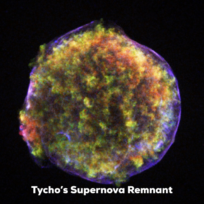
• NOV 6 – In 1572, Tycho Brahe records seeing a supernova in the constellation of Cassiopeia.
• NOV 7 – The moon is at apogee, its most distant point in its orbit from Earth at 2:36 AM CST, at a distance of 251,691 miles away.
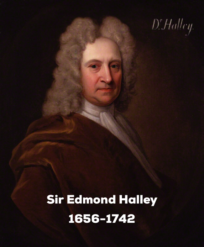 • NOV 8 – Sir Edmond Halley was born this day in 1656. His contributions to physics and astronomy are multitude. After viewing a transit of Mercury, he realized that, with a transit of Venus, one could determine the distance between the Earth and the Sun. The principle is fairly straightforward: 1) establish a baseline between two observers on opposite sides of the Earth. Due to the wide distance, each observer will see Venus transit the solar disc at different points on the Sun’s face 2) each observer then measures the timing and the angular difference in Venus’s path across the solar disc 3) by comparing notes and applying trigonometry, the observers can work out the distance to Venus and 4) by using known relative distances it then becomes possible to work out the distance to the Sun. This allowed us to determine the size of the solar system. Halley also worked out the orbits of comets, including the famous one that bears his name and passes through the solar system once every 75 years. He cataloged many stars in the southern hemisphere and arranged for the publication of Sir Isaac Newton’s “Principia”, the single most important scientific publication in history. Halley also served as Royal Astronomer from 1720 until his death, becoming the second person to hold that honored position.
• NOV 8 – Sir Edmond Halley was born this day in 1656. His contributions to physics and astronomy are multitude. After viewing a transit of Mercury, he realized that, with a transit of Venus, one could determine the distance between the Earth and the Sun. The principle is fairly straightforward: 1) establish a baseline between two observers on opposite sides of the Earth. Due to the wide distance, each observer will see Venus transit the solar disc at different points on the Sun’s face 2) each observer then measures the timing and the angular difference in Venus’s path across the solar disc 3) by comparing notes and applying trigonometry, the observers can work out the distance to Venus and 4) by using known relative distances it then becomes possible to work out the distance to the Sun. This allowed us to determine the size of the solar system. Halley also worked out the orbits of comets, including the famous one that bears his name and passes through the solar system once every 75 years. He cataloged many stars in the southern hemisphere and arranged for the publication of Sir Isaac Newton’s “Principia”, the single most important scientific publication in history. Halley also served as Royal Astronomer from 1720 until his death, becoming the second person to hold that honored position.
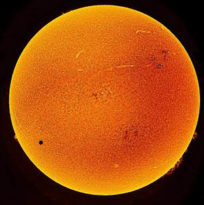
• NOV 11 – SPECIAL OBSERVING TREAT: The planet Mercury will pass across the face of the Sun. Here in Little Rock, that begins at 6:39 AM, reaches its midpoint at 9:20 AM, and then ends by 12:04 PM for a total of 5 hours and 25 minutes. You will need a solar filtered telescope to see the event. See the monthly feature for more details.
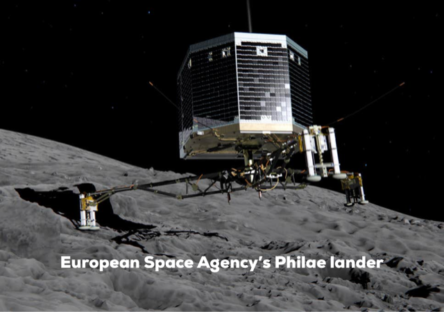
• NOV 12 Moon is at full phase.
On this day in 2014, the European Space Agency’s Philae probe became the first spacecraft to land upon a comet, 67P/Churyumov–Gerasimenko.
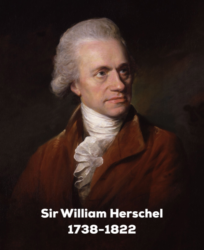 • NOV 15 – Famed English astronomer, Sir William Herschel was born this day in 1738. Aside from conducting a comprehensive deep sky survey which, with the aid of his sister Caroline, led to the New General Catalog of deep sky objects, Herschel also conducted numerous observations of double stars and discovered the planet Uranus (which resulted in his appointment as court astronomer by King George III).
• NOV 15 – Famed English astronomer, Sir William Herschel was born this day in 1738. Aside from conducting a comprehensive deep sky survey which, with the aid of his sister Caroline, led to the New General Catalog of deep sky objects, Herschel also conducted numerous observations of double stars and discovered the planet Uranus (which resulted in his appointment as court astronomer by King George III).
• NOV 17/18 – The Leonid meteor shower peaks, unfortunately, the waning moon will spoil the view.
• NOV 19 – The moon is at last quarter. Apollo 12 became the second manned spacecraft to successfully land upon the moon.
• NOV 20 – Edwin Hubble was born this day in 1889.
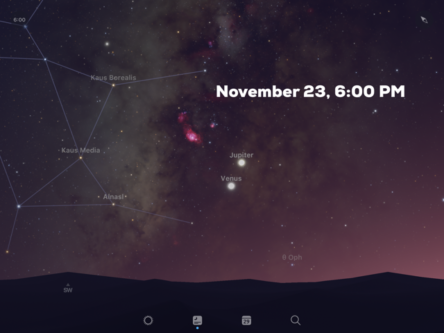
• NOV 23/24 SPECIAL OBSERVING TREAT: At around 6:00 PM CST, get outside and look low along the western horizon to see a splendid conjunction between the planets Venus and Jupiter. No optical aid needed!
At 1:41 AM CST, the moon reaches perigee, its closest point in its orbit to Earth, at a distance of 227,867 miles away.
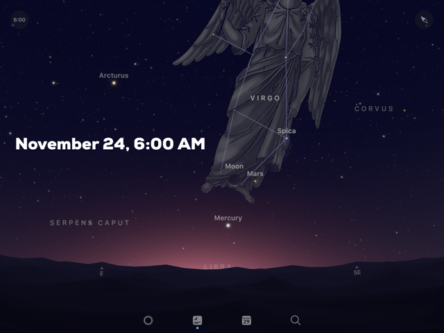
• NOV 24 – Before sunrise, get outside and look east to see the waning crescent moon and Mars forming a conjunction in the eastern sky.
• NOV 26 – The moon is now at new phase.
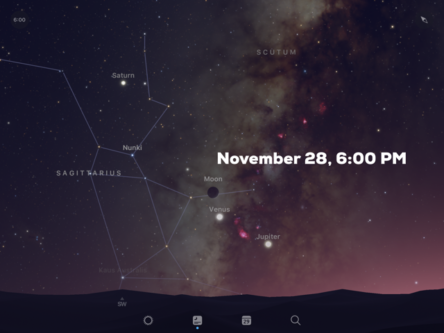 • NOV 28 SPECIAL OBSERVING TREAT: Yet another great conjunction, this time involving a thin crescent moon, Venus, and Jupiter. Look westward right after sundown, low to the horizon, and see if you can catch this solar system trio. No optical aid needed.
• NOV 28 SPECIAL OBSERVING TREAT: Yet another great conjunction, this time involving a thin crescent moon, Venus, and Jupiter. Look westward right after sundown, low to the horizon, and see if you can catch this solar system trio. No optical aid needed.
HAPPY THANKSGIVING!
- NOV 30 – Free public star party at Woolly Hollow State Park, 82 Woolly Hollow Rd., Greenbrier, AR. Join members of the Central Arkansas Astronomical Society for their last star party of the year. Look through their telescopes to see the many wonders currently overhead, learn about the constellations, deep sky objects, and more. Fun and family friendly!